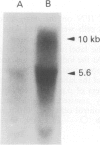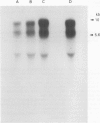Abstract
The interferons are a group of naturally occurring proteins that inhibit the growth of tumours in vivo and many transformed cell lines in vitro. The mechanisms of action of interferon, however, remain unclear. The IFN induced inhibition of growth of many epithelial cancer cell lines is associated with changes in Epidermal Growth Factor Receptor (EGFR) binding or expression. Therefore, we examined the effect of IFN treatment on the expression of EGFR in a human breast carcinoma cell line, MDA 468. We have found the IFN-gamma inhibited, in a dose dependent fashion, the growth of MDA 468 cells. IFN decreased cell surface binding of 125I-EGF to EGFR by changing receptor number rather than affinity. However, total cellular receptor protein, as measured by immunoprecipitation with monoclonal antibodies, was increased in IFN-treated cells. The half-life of the metabolically labelled receptor was unchanged by treatment with IFN. Increased amounts of EGFR mRNA were observed in MDA 468 cells treated with IFN-gamma for 3 days. The levels of mRNA increased with time in culture, reaching a peak of four times control values after 5 days of treatment. This effect was observable with as little as 10 U ml-1 of IFN-gamma. Treatment of the cells with Actinomycin D to inhibit new RNA synthesis suggested that the stability of EGFR mRNA was not enhanced in IFN-gamma treated cells. The increase in receptor mRNA induced by IFN was not inhibited by cycloheximide. These data suggest IFN-gamma can increase expression of EGFR mRNA and protein in MDA 468 cells. Increased expression of EGFR mRNA and protein by IFN-gamma is associated with inhibition of cell growth.
Full text
PDF




Images in this article
Selected References
These references are in PubMed. This may not be the complete list of references from this article.
- Balkwill F. R., Moodie E. M., Freedman V., Fantes K. H. Human interferon inhibits the growth of established human breast tumours in the nude mouse. Int J Cancer. 1982 Aug 15;30(2):231–235. doi: 10.1002/ijc.2910300217. [DOI] [PubMed] [Google Scholar]
- Bernstein W., Zou Z. Q., Black R. J., Pirollo K. F., Chang E. H. Association of interferon-gamma induced growth inhibition and modulation of epidermal growth factor receptor gene expression in squamous cell carcinoma cell lines. J Biol Regul Homeost Agents. 1988 Oct-Dec;2(4):186–192. [PubMed] [Google Scholar]
- Bjorge J. D., Kudlow J. E. Epidermal growth factor receptor synthesis is stimulated by phorbol ester and epidermal growth factor. Evidence for a common mechanism. J Biol Chem. 1987 May 15;262(14):6615–6622. [PubMed] [Google Scholar]
- Bjorge J. D., Paterson A. J., Kudlow J. E. Phorbol ester or epidermal growth factor (EGF) stimulates the concurrent accumulation of mRNA for the EGF receptor and its ligand transforming growth factor-alpha in a breast cancer cell line. J Biol Chem. 1989 Mar 5;264(7):4021–4027. [PubMed] [Google Scholar]
- Brachmann R., Lindquist P. B., Nagashima M., Kohr W., Lipari T., Napier M., Derynck R. Transmembrane TGF-alpha precursors activate EGF/TGF-alpha receptors. Cell. 1989 Feb 24;56(4):691–700. doi: 10.1016/0092-8674(89)90591-6. [DOI] [PubMed] [Google Scholar]
- Bradley E. C., Ruscetti F. W. Effect of fibroblast, lymphoid, and myeloid interferons on human tumor colony formation in vitro. Cancer Res. 1981 Jan;41(1):244–249. [PubMed] [Google Scholar]
- Chirgwin J. M., Przybyla A. E., MacDonald R. J., Rutter W. J. Isolation of biologically active ribonucleic acid from sources enriched in ribonuclease. Biochemistry. 1979 Nov 27;18(24):5294–5299. doi: 10.1021/bi00591a005. [DOI] [PubMed] [Google Scholar]
- Clark A. J., Ishii S., Richert N., Merlino G. T., Pastan I. Epidermal growth factor regulates the expression of its own receptor. Proc Natl Acad Sci U S A. 1985 Dec;82(24):8374–8378. doi: 10.1073/pnas.82.24.8374. [DOI] [PMC free article] [PubMed] [Google Scholar]
- Fernandez-Pol J. A., Klos D. J., Hamilton P. D., Talkad V. D. Modulation of epidermal growth factor receptor gene expression by transforming growth factor-beta in a human breast carcinoma cell line. Cancer Res. 1987 Aug 15;47(16):4260–4265. [PubMed] [Google Scholar]
- Filmus J., Pollak M. N., Cailleau R., Buick R. N. MDA-468, a human breast cancer cell line with a high number of epidermal growth factor (EGF) receptors, has an amplified EGF receptor gene and is growth inhibited by EGF. Biochem Biophys Res Commun. 1985 Apr 30;128(2):898–905. doi: 10.1016/0006-291x(85)90131-7. [DOI] [PubMed] [Google Scholar]
- Filmus J., Trent J. M., Pollak M. N., Buick R. N. Epidermal growth factor receptor gene-amplified MDA-468 breast cancer cell line and its nonamplified variants. Mol Cell Biol. 1987 Jan;7(1):251–257. doi: 10.1128/mcb.7.1.251. [DOI] [PMC free article] [PubMed] [Google Scholar]
- Kumar R., Mendelsohn J. Growth regulation of A431 cells. Modulation of expression of transforming growth factor-alpha mRNA and 2',5'-oligoadenylate synthetase activity. J Biol Chem. 1990 Mar 15;265(8):4578–4582. [PubMed] [Google Scholar]
- Nickoloff B. J., Mitra R. S. Inhibition of 125I-epidermal growth factor binding to cultured keratinocytes by antiproliferative molecules gamma interferon, cyclosporin A, and transforming growth factor-beta. J Invest Dermatol. 1989 Dec;93(6):799–803. doi: 10.1111/1523-1747.ep12284427. [DOI] [PubMed] [Google Scholar]
- Raymond V. W., Grisham J. W., Earp H. S. Characterization of epidermal growth factor receptor induction by retinoic acid in a chemically transformed rat liver cell line. Cell Growth Differ. 1990 Sep;1(9):393–399. [PubMed] [Google Scholar]
- Rizzino A., Kazakoff P., Ruff E., Kuszynski C., Nebelsick J. Regulatory effects of cell density on the binding of transforming growth factor beta, epidermal growth factor, platelet-derived growth factor, and fibroblast growth factor. Cancer Res. 1988 Aug 1;48(15):4266–4271. [PubMed] [Google Scholar]
- Zoon K. C., Karasaki Y., zur Nedden D. L., Hu R. Q., Arnheiter H. Modulation of epidermal growth factor receptors by human alpha interferon. Proc Natl Acad Sci U S A. 1986 Nov;83(21):8226–8230. doi: 10.1073/pnas.83.21.8226. [DOI] [PMC free article] [PubMed] [Google Scholar]
- van den Berg H. W., Leahey W. J., Lynch M., Clarke R., Nelson J. Recombinant human interferon alpha increases oestrogen receptor expression in human breast cancer cells (ZR-75-1) and sensitizes them to the anti-proliferative effects of tamoxifen. Br J Cancer. 1987 Mar;55(3):255–257. doi: 10.1038/bjc.1987.49. [DOI] [PMC free article] [PubMed] [Google Scholar]









